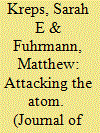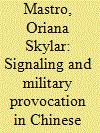| Srl | Item |
| 1 |
ID:
104330


|
|
|
|
|
| Publication |
2011.
|
| Summary/Abstract |
What are the consequences of military strikes against nuclear facilities? In particular, do they 'work' by delaying the target states ability to build the bomb? This article addresses these questions by conducting an analysis of 16 attacks against nuclear facilities from 1942 to 2007. We analyze strikes that occurred during peacetime and raids that took place in the context of an ongoing interstate war. The findings indicate that strikes are neither as uniformly fruitless as the skeptics would suggest, nor as productive as advocates have claimed. There is evidence that the peacetime attacks delayed the target's nuclear program, although the size of this effect is rather modest. The wartime cases were less successful, as attacks often missed their targets either due to operational failure or limited intelligence on the location of critical targets. In our concluding section we show that many of the conditions that were conducive to past success are not present in the contemporary Iran case. Overall, our findings reveal an interesting paradox. The historical cases that have successfully delayed proliferation are those when the attacking state struck well before a nuclear threat was imminent. Yet, this also happens to be when strikes are the least legitimate under international law, meaning that attacking under these conditions is most likely to elicit international censure.
|
|
|
|
|
|
|
|
|
|
|
|
|
|
|
|
| 2 |
ID:
104331


|
|
|
|
|
| Summary/Abstract |
US Military Power
Post-Cold War US Defence Policy
Major Theatre Wars
Unipolar Era
|
|
|
|
|
|
|
|
|
|
|
|
|
|
|
|
| 3 |
ID:
104333


|
|
|
|
|
| Publication |
2011.
|
| Summary/Abstract |
This article argues that the dominant paradigm in studies of British small wars positing a central role of minimum force in doctrinal guidelines for counterinsurgency needs to be even more fundamentally revised than has been argued in recent debates. More specifically, it argues that minimum force is nowhere to be found in British doctrine during the small wars of decolonisation. The need for revision also applies to the way British counterinsurgency is usually sharply contrasted with French counterinsurgency. British doctrine during this period is better understood when placed in its proper historical context. This means comparing it with the other two most significant examples of doctrinal development for small wars of decolonisation - those of France and Portugal. This comparison shows that British counterinsurgency was not uniquely population-centric, and this characteristic cannot, therefore, be the reason for its arguably superior if far from infallible performance. Evidence for these arguments comes primarily from doctrinal sources developed specifically to deal with counterinsurgency, complemented with insights from key military thinkers and archival sources of relevance practices. Some wider implications of this analysis for the relationship between combat experience and doctrinal development as well as for counterinsurgency are identified.
|
|
|
|
|
|
|
|
|
|
|
|
|
|
|
|
| 4 |
ID:
104332


|
|
|
|
|
| Publication |
2011.
|
| Summary/Abstract |
On 8 March 2009, five Chinese vessels shadowed and aggressively maneuvered in close proximity to the US Naval Ship (USNS) Impeccable. This paper seeks to explain the incident and its aftermath in the context of Chinese coercive diplomacy. China's strategy, designed to motivate the US to cease surveillance operations near its militarily sensitive areas in the South China Sea, included three components: (1) the use of military provocation, (2) a coordinated media campaign, and (3) a challenge to US interpretations of the United Nations Convention on the Law of the Seas (UNCLOS). This study goes beyond traditional research on Chinese use of force to explain why China's coercive diplomatic campaign took the form it did. Only by understanding the nature and factors affecting Chinese coercive diplomacy can the US design the effective counter strategy needed to protect US regional and global interests.
|
|
|
|
|
|
|
|
|
|
|
|
|
|
|
|